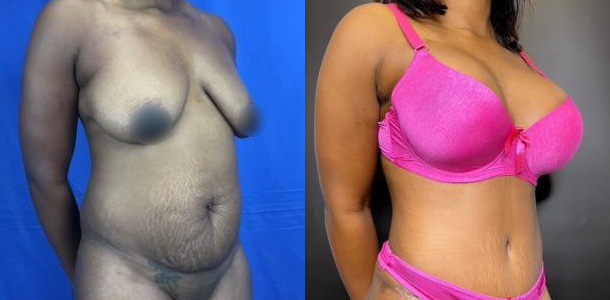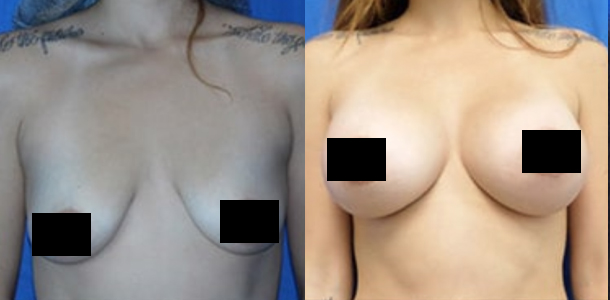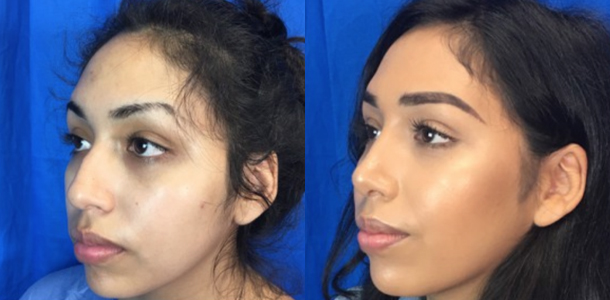Lap Band Removal
Consultations offered at our three convenient locations in Pomona, Rancho Cucamonga and Apple Valley, CA

A laparoscopic band removal procedure is necessary when the device causes unwanted side-effects, or if lap-band-related complications pose a health risk to the patient. Bariatric surgeries seek to restrict how much a person can eat, and help them feel fuller faster. The aim of this type of weight-loss device is to reduce appetite. The surgeon places the adjustable band at the very top of the stomach. In this position, it compresses the gastric wall, causing nerves in the stomach to send satiety (fullness) signals to the brain.
But when a lap band doesn’t function as intended, a patient may see a plateau, or even an increase in their weight. They could also experience uncomfortable side-effects like nausea and vomiting, difficulty swallowing, and gastroesophageal reflux. And, in the most serious cases, the band can damage the stomach wall, or the port site can become infected, requiring its immediate removal. Although many lap-band issues can be resolved with adjustment, it is never healthy or safe to continue using a bariatric device if potentially serious complications arise.
Board-certified bariatric surgeon Dr. Lee Au offers lap band removal procedures at Pacific Med Health Group. With locations in Pomona, and Apple Valley, we provide effective weight-loss surgeries, revisions, and removal procedures to help patients start, or alter, their weight-loss journey in a healthy way. Contact your nearest office by calling (800) 555-5551, or by filling in our simple online form to book your personal consultation with one of Southern California’s leading weight-loss surgeons!
Contents
Reasons to Remove a Lap Band
First introduced to the United States in 2001, the adjustable laparoscopic band gained popularity in the early years of the 21st century. However, it would later be eclipsed by other weight-loss surgeries. The success of the sleeve gastrectomy saw a decline in the lap band’s popularity. Unlike the lap band, the gastric sleeve could restrict food intake and decrease the absorption of nutrients by refashioning the stomach into a long sleeve-like shape. (1) And as well as the gastric sleeve, the “gold standard bariatric procedure” gastric bypass was yet another effective solution to excess weight.
Gastric banding helps many patients safely and successfully reach a healthier weight every year. Most patients receive consistent care, and visit their surgeon for regular adjustments to tighten or loosen the band, changing the volume of saline solution to increase or decrease satiety. And although lap band complications are uncommon for the majority of patients, they can, and do, occur.
Food Intolerance
Everybody reacts differently to weight-loss surgery, and for many patients, food intolerance can be an uncomfortable side-effect of gastric banding. Doctors provide specific dietary guidelines following placement of the device. But if a patient is unable to follow this nutrition guidance, they may experience nausea, vomiting, and an inability to digest certain foods. Much of the time, this can be resolved with a band adjustment, however, more severe food intolerance issues may require surgery to remove the device. In fact, research has shown that food intolerance may be the most common long-term cause of lap band removal. (2)
Pouch Enlargement
Also known as type III-prolapse, pouch enlargement is a dilation of the banded stomach portion. As the volume of the pouch is greater, patients may experience the following symptoms:
- Lack of Fullness
- Heartburn
- Regurgitation
- Chest Pain
Doctors may advise dietary change, better portion control, or band deflation as conservative measures to resolve pouch enlargement symptoms. However, if these are unsuccessful, lap band removal or replacement may be the only options. (3)
Band Slippage
Type I & II Prolapse
A small percentage of laparoscopic bands slip from their intended position. A portion of the stomach can herniate through the band anteriorly (the “front” of the stomach”) in a type-I prolapse, or posteriorly (the “back” of the stomach) in a type-II prolapse. When this happens, patients may experience difficulty swallowing, vomiting, food intolerance, and regurgitation. (3)
Type IV & V Prolapse
Immediate slippage soon after the original surgery is known as a type IV prolapse, while tissue necrosis in the slipped stomach is a type V prolapse. Most band slippage events (I, II, IV, and V) require surgery to reposition or remove the band. (3)
Band Erosion
Occurring in less than 1% of cases, band erosion is a serious complication where the band erodes through the stomach wall. Much of the time, band erosion is symptomless, but some patients may experience pain in the mid-abdomen, infection and gastro-intestinal bleeding. In these cases, complete gastric band removal is recommended. (3)
Port Site Infection & Damage
The port is the access point during lap band adjustment, where band restriction can be increased or decreased. Sometimes, this site can become infected or damaged. As infections don’t usually respond well to antibiotics, the fastest way to resolve this issue is gastric band removal. (3) And if the mechanism or the tubing attached is damaged, it must be removed or replaced.
For a thorough assessment of your lap-band function, and information about lap band removal, book a personal consultation with Dr. Au. Call us at (800) 555-5551 to schedule your consultation in Apple Valley, or Pomona.
Personal Consultation
Dr. Au will gather information from you about your primary gastric banding procedure at your personal consultation. If the cause of your lap band issues has not yet been established, he may wish to perform tests, order X-rays, and conduct internal and external examinations of the stomach and port site. He will also ask you for details of any weight changes, dietary changes, or unwanted side-effects. Once the issue has been diagnosed, he will inform you of his intended treatment pathway. If removal is the best route, Dr. Au will base a band removal treatment plan around his findings.
Contact us today to schedule your lap band removal consultation with Dr. Au.
What Happens Next?
Preparing for Surgery
Once your surgery is scheduled, we will give you some instructions to prepare. Lap band removal procedures can be performed for many different reasons, so the nature of your treatment plan will be personal to you. In most cases, we will ask you to do the following.
- If you take blood thinners (e.g. Plavix), speak to your prescribing doctor about how coming off them completely will affect you. Blood thinning medications of any kind, including over-the-counter pain relief (e.g. aspirin) should be avoided for at least two weeks before your surgery date.
- We will ask you to inform us about any vitamins or dietary supplements you are currently taking, as these can also thin the blood. This is a feature of many supplements, including garlic, ginkgo biloba, vitamin E, and turmeric. You must also discontinue using these before your procedure.
- There are usually no dietary restrictions other than those you already follow. However, you must stop food and liquid intake before midnight the evening before your surgery. If you have to take medication, this should only be done with a sip of water.
Your Lap Band Removal Procedure
On your surgery day, Dr. Au will use your individualized treatment plan to remove your lap band. This surgery is highly varied in its approach, and may be performed laparoscopically or via open surgery. As with any surgery recovery, you must follow your aftercare instructions very carefully.
After the Procedure

It is very important that you take time to rest for the duration of your recovery period, so your body can heal as quickly as possible. As is expected after any surgery, your abdomen will be swollen and bruised. You may also feel bloating and/or aches in other areas of your body, particularly shoulder pain. This pain sometimes occurs because the gas used in the surgery irritates the phrenic nerve.
To relieve discomfort, Dr. Au will prescribe pain medication, and stool softeners to counter the effects of the pain medication on your digestive system. If you have a drain, or if a foley catheter is required, Dr. Au will give you instructions regarding them, and a timeline for their removal. Importantly, you must not conduct any strenuous activities until you have recovered fully. Dr. Au encourages light walking to aid healing, but heavy lifting, straining, vigorous exercise like running, and sexual intercourse should be avoided. You may resume these activities after roughly 10 days if your removal surgery was performed laparoscopically. However, open surgery will require a lengthier period of rest of up to 6 weeks.
If you experience anything out of the ordinary during your recovery, please get in touch with our office as soon as possible. Dr. Au and the staff at Pacific Med Health Group are here to ensure you have a successful lap band removal surgery, and a speedy recovery!
Cost of Lap Band Removal in Pomona, CA
Every lap band removal procedure performed at Pacific Med Health Group is based on the specific needs of the patient. As it is important to individualize treatment, the cost of your procedure will vary according to Dr. Au’s recommendations. To arrange your one-on-one lap band removal consultation with us, call (800) 555-5551 to book in Pomona, or Apple Valley.
Read more about weight-loss surgery and other services offered at Pacific Med Health Group on our blog.
References
- Seeras, K., Acho, R. J., & Prakash, S. (2021). Laparoscopic Lap Band Placement. PubMed; StatPearls Publishing. https://www.ncbi.nlm.nih.gov/books/NBK526062/
- Dargent J. Isolated Food Intolerance After Adjustable Gastric Banding: A Major Cause of Long-Term Band Removal. Obesity Surgery. 2008;18(7):829-832. doi:10.1007/s11695-008-9495-x
- Eid I. Complications associated with adjustable gastric banding for morbid obesity: a surgeon’s guide. Canadian Journal of Surgery. 2011;54(1):61-66. doi:10.1503/cjs.015709



